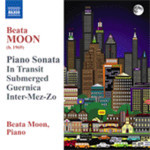
Piano Works
 $25.00
Out of Stock
$25.00
Out of Stock6+ weeks add to cart
BEATA MOON
Piano Works
Beata Moon (piano)
[ Naxos / CD ]
Release Date: Tuesday 17 July 2007
This item is currently out of stock. It may take 6 or more weeks to obtain from when you place your order as this is a specialist product.
"The majority of works here are short, and are ideal as recital pieces as they would complement both traditional and contemporary works"
(MusicWeb July 2007)
"In general, I enjoyed listening to this CD. I particularly enjoyed the more dissonant moments, perhaps partially because they provided variety and partially because I was at times willing Ms Moon to let rip a little more. The piano playing is excellent and the sound quality of the recording is impressive. I was particularly attracted by the clarity of the recording. However, for me, a whole disc of this music was too much. A little more variety was needed to maintain my interest. The majority of works here are short, and are ideal as recital pieces as they would complement both traditional and contemporary works"
(MusicWeb July 2007)
Primarily self-taught as a composer yet vigorously trained as a pianist, Korean-American Beata Moon creates music that is simultaneously unbeholden to any compositional trend or dogma, while completely idiomatic and informed by a wide purview of music history.
Clocking in at approximately sixteen minutes, the four-movement Piano Sonata (2006) is the longest and most ambitious of her solo piano compositions to date. Piano sonatas – according to the tradition handed down from Haydn, Mozart, and Beethoven, and filtered through recent composers as diverse as Barber, Carter, Persichetti, or Zaimont – tend to be abstract and serious musical statements. While Moon's sonata is clearly still within that mould, she manages to maintain some of her music's characteristic buoyancy, which makes her sonata a refreshing and timely response to the genre's legacy. In the magisterial first movement, the piano evokes bells and chorales. Next comes a lively dance predominantly in five. The more sombre third movement, almost in strict four-part harmony throughout, is practically a commercial for how good parallel fifths sound on the piano, despite what centuries of music theorists had claimed. The finale, a virtuoso cascade of almost incessant figuration, brings the proceedings to an exciting conclusion.
Submerged (1999), a mysterious tone poem that recalls the ultra-modernist pyrotechnics of Scriabin and Leo Ornstein, is a timbral exploration of many infrequently-explored combinations of the piano's three foot pedals. In Transit (1999) is a short suite of five interrelated movements, which also exists in a version for orchestra. It follows in the delightful tradition of sonic vignettes about New York City, which is where Moon lives. The titles of individual movements are mostly accurate verbal descriptions of the music contained with them: e.g. 'Hubbub', 'Chug-a', 'Sub (conscious) Way'. However, according to the composer, one of the movements, ' Leonard Street ', has a slightly different meaning here than the street in Lower Manhattan named for the son of an eighteenth-century real estate magnate. In Moon's universe, Leonard Street is named after Leonard Bernstein, a composer who along with Barber, Gershwin, and Copland, has directly inspired her. After these delightful miniatures, Guernica (2003), the least discernibly tonal of her compositions, is more than a little bit unsettling, and intentionally so. A personal response to Bush's declaration of war on Iraq, the music is a turbulent rumble that begins in 11/8 before wandering through a variety of never completely stable metres. But Moon is ultimately an optimist: the ending almost hints at a resolution. Let us hope she is prophetic as well.
Inter-Mez-Zo (2006) returns to the playfulness of In Transit, but adds several new twists. The three uninterrupted movements – 'Inter', 'Mez' and 'Zo' – explore three different moods. 'Inter' is a perky frolic mostly in her beloved quintuple metre. 'Mez' demonstrates diatonic applications to cluster-like harmonies, creating a rich, sensuous edifice around a lilting tune. 'Zo', a frenetic, quasi-minimalist perpetuum mobile, evokes a car chase that goes on relentlessly until the very last breathless moment. That final movement is somewhat reminiscent of Moon's earlier Toccata (2000), another work that demonstrates the kinds of flights of fancy that can occur when the composer and the pianist are the same person.
Ode (1998), composed in homage to Debussy, never firmly emphasizes its tonality. Beginning with almost full diatonic clusters, the music strays both harmonically and metrically through a maze of detours before culminating with a vague hint of B flat major that is ultimately blurred by suspensions. Piano Fantasy (1998) is perhaps the most unashamedly diatonic piece here, but it too has some surprises. While beginning firmly in B minor, it eventually ends up rather unexpectedly in F sharp major. Nursery (1996), a tribute to Japanese composer Akira Nishimura, is a haunting and mysterious series of slow, sustained chords. The Secret (2005) is mysterious in other ways: over the course of only three and half minutes, a motive gets transformed from a melodic figure to the basis of a prominent series of harmonies to an accompanying bass line. Finally, Prelude (1995), the earliest of the works featured here and the first piano piece Moon ever composed, is a lush quasi-impressionistic, post-minimalistic lullaby in G major that begins and ends in 13/16 time. It was an auspicious beginning, but here it excellently serves as a beautiful summation of this amalgamation of Beata Moon's first decade of compositions for the piano.
Tracks:
Piano Sonata
Submerged
In Transit
Guernica
Inter-Mez-Zo
Toccata
Ode
Piano Fantasy
Nursery
The Secret
Prelude


